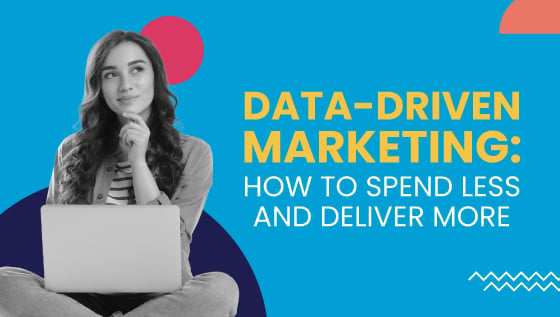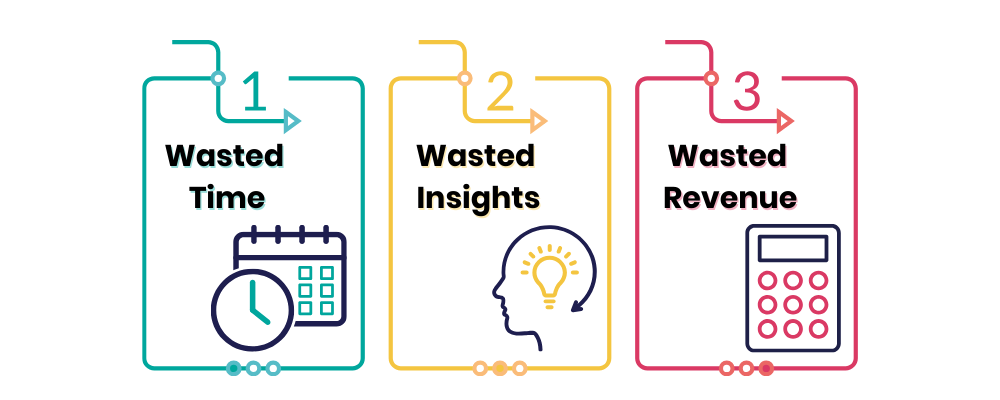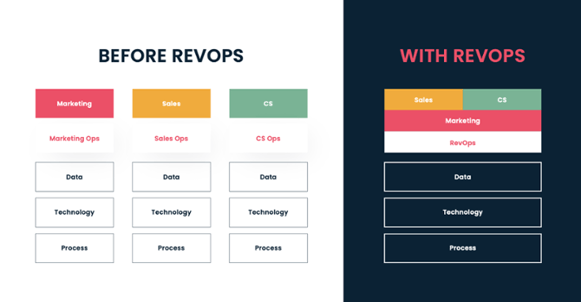






Let's talk data!
The powerhouse of every successful business, data can help scale growth and drive revenue when collected and used in the right way.
This blog delves into how data-driven marketing strategies enhance efficiency and maximise revenue.
Take a look at the topics we explore in detail:
| 1. | |
| 2. | Data-Driven Marketing as the Solution |
| 3. | Examples of Data-Driven Marketing |
| 4. | The Role of RevOps in Data-Driven Marketing |
| 5. | Tips for Implementing Data-Driven Marketing |
In a data-driven culture, marketing strategies are built using insights gathered from analysis of customer behaviour and engagements. By eliminating guesswork, marketers can now make informed decisions to deliver personalised experiences following data-driven marketing, ultimately leading to increased customer loyalty and revenue growth.
However, an abundance of data doesn't necessarily mean success - data quality, management and analysis are the secret sauce!
A lot of modern data issues like bad data, siloed data, duplication, manual tracking, etc. can create a dent in your data-driven marketing strategy and affect your revenue operations (RevOps).
Let's dig deeper into data-less marketing and its challenges:
Pitfalls of Data-Deficient Marketing
Marketing without data relies heavily on intuition and assumptions, hindering the ability to precisely measure success. When a company neglects data-driven marketing, it results in a significant waste of time, talent, and resources. Without data insights, efforts can be misdirected, and talented individuals may operate without a clear understanding of what strategies are effective.
Essentially, without data, both human potential and organisational assets are underutilised, resulting in missed opportunities and suboptimal outcomes.

1. Wasted Time
Inefficient manual processes and redundant workflows without data-driven insights lead to increased manual tasks, hampering efficiency and diverting resources from strategic endeavours.
2. Wasted Talent & Insights
Neglected talent and lack of data-backed decision-making in marketing prevent the full utilisation of team expertise, diminishing innovative problem-solving potential and limiting collective wisdom application.
3. Wasted Revenue
Wasted selling time and revenue result from ineffective targeting and missed conversion opportunities due to the absence of customer insights, hindering sales strategies and prolonging conversion cycles.
Data-Driven Marketing as the Solution
Data-driven marketing tackles inefficiency and resource waste by optimising targeting, automating repetitive tasks, streamlining workflows, personalising campaigns, and facilitating real-time adjustments. By leveraging data, businesses can operate with greater precision, ensuring that resources are allocated effectively and efforts yield maximum impact.
A. Harnessing Insights for Strategic Decision Making
1. Customer Segmentation
With access to customer behaviour and preferences, marketers can precisely target specific audience segments more effectively, tailoring messages and offers to resonate with the unique characteristics of each group.
2. Predictive Analytics
Allowing marketers to foresee customer trends and behaviours, businesses can make proactive decisions and adjust strategies in advance, staying ahead of the curve in a dynamic market.
3. Channel Optimisation
By determining the most effective channels for reaching the target audience we can understand where their audience spends time and, hence can optimise our presence on social media, search engines, or other relevant platforms.
B. Efficiency in Operations
1. Automation of Repetitive Tasks
Data-driven marketing introduces automation into the picture relieving teams of repetitive tasks. This not only saves time but also enhances focus on strategic thinking and decision-making processes, allowing the workforce to concentrate on high-impact activities.
2. Streamlining Workflows
Leveraging data, businesses can streamline and optimise workflows, helping improve operational efficiency but also ensuring that resources are allocated effectively, reducing bottlenecks and enhancing the overall productivity of marketing processes.
3. Resource Allocation
Understanding which touchpoints and interactions have the most impact on conversions is crucial for marketers. This valuable insight allows for effective resource allocation and optimisation of future campaigns, leading to better results and higher ROI.
C. Maximising Selling Time and Revenue
1. Personalised Marketing Campaigns
By analysing customer data, businesses can tailor marketing efforts to resonate with individual preferences. This personalised approach significantly boosts conversion rates, as customers are more likely to engage with content that aligns with their specific needs and interests.
2. Real-Time Analytics for Agile Adjustments
By monitoring campaign performance in real-time, businesses can identify what works and what doesn't. This allows for swift adjustments to marketing strategies, ensuring maximum effectiveness and return on investment (ROI) in a rapidly changing market landscape.
Examples of Data-Driven Marketing
👉 Customer Segmentation: Amazon
Amazon utilises customer segmentation by analysing user behaviour, purchase history, and preferences. This allows them to categorise customers into segments and personalise recommendations. As a result, Amazon has significantly increased its cross-selling and upselling capabilities, leading to higher customer satisfaction and increased revenue.
👉 Automation & Workflows: Spotify
Spotify leverages data-driven automation in its recommendation algorithms. By analysing user listening patterns, genres, and preferences, Spotify's algorithms automatically curate personalised playlists for each user. This level of automation enhances the user experience, keeps users engaged, and contributes to increased user retention and premium subscriptions.
👉 Personalised Campaigns: Netflix
Netflix is a prime example of personalising content recommendations based on user data. By analysing viewing history, search patterns, and user ratings, Netflix tailors its content suggestions for each viewer. This personalisation strategy has significantly improved user engagement, increased content consumption, and played a pivotal role in retaining a large subscriber base.
The Role of RevOps in Data-Driven Marketing

RevOps plays a crucial role in data-driven marketing by aligning and optimising processes across sales, marketing, and customer success to drive revenue growth. Its role includes:
1. Integration of Data
RevOps integrates data from various sources, including marketing automation platforms, CRM systems, and customer support tools. This ensures a unified and comprehensive view of customer interactions, which helps enhance planning the data-driven marketing strategy.
2. Cross-departmental Collaboration
By breaking down silos and aligning the sales, marketing, and customer service teams, RevOps opens up the ground for effective communication where data and insights can be shared seamlessly, leading to a cohesive and aligned approach to customer engagement.
3. Customer journey mapping
By enforcing the alignment of teams and integration of data, RevOps ensures a unified and comprehensive view of customer interactions. This helps identify critical touchpoints where data-driven insights can be leveraged to enhance the overall customer experience and drive conversions.
4. Tech stack optimisation
By fostering data integration, streamlining workflows, enabling real-time data access, enhancing personalisation capabilities, and facilitating robust analytics - a well-optimised stack empowers marketers to harness the full potential of data for more effective and efficient marketing practices.
5. Continuous optimisation
Evolution is the name of the game, and RevOps is all about continuously optimising based on data feedback. This iterative process involves adapting strategies in real-time, refining campaigns, and adjusting tactics to align with changing market dynamics and customer behaviours.
Tips for Implementing Data-Driven Marketing
RevOps allow you to consolidate data from different sources and analyse it holistically to effectively leverage real-time tracking. Such a culture ensures informed decision-making based on shared data, promoting alignment and cohesion toward common goals.
Let's explore some tips to implement data-driven marketing within your RevOps strategy:
1. Establish clear goals
Define specific, measurable, and aligned objectives to clearly outline what you aim to achieve with data analytics and how it contributes to overall RevOps.
2. Foster a data-driven culture
Establish a data-driven culture by encouraging all employees to use data for decision-making and real-time recommendations. Encourage a "data-first" approach: empowering teams, sharing responsibilities, and ensuring cross-departmental collaboration within meetings focusing on data-driven insights.
3. Invest in training and skill development
Empower employees to use data effectively by offering training and resources. Provide workshops or online courses tailored to different expertise levels and departments to encourage ongoing learning and development/
4. Centralise data management
Integrate various data sources, including CRM systems, marketing automation platforms, and sales tools. This integration ensures a unified and comprehensive dataset for analysis, fostering cohesive insights across RevOps functions.
5. Regularly audit and clean data
Establish processes for regularly auditing and cleaning data to maintain accuracy and reliability. Clean and accurate data is fundamental for meaningful insights and effective decision-making.
6. Define key metrics and KPIs
Identify key performance indicators (KPIs) aligned with revenue goals to clearly define the metrics that will be tracked and measured to assess the success of data-driven marketing initiatives.
7. Implement customer segmentation
Utilise data to segment customers based on behaviour, preferences, and demographics to tailor marketing and sales strategies to specific segments, enhancing the relevance of interactions and improving conversion rates.
8. Track and analyse in real-time
To enhance data-driven decision-making, implement real-time monitoring and reporting for RevOps teams to respond promptly to market changes. Regularly review and analyse data trends, establish reporting processes, and create visualisation tools for insights. Invest in strategies that involve the active use of data to inform decisions, going beyond observation to drive revenue growth.
The challenges of data-deficient marketing such as wasted time and effort, and missed opportunities can be easily overcome by leveraging insights from data. Fostering a data-driven culture within your RevOps helps encourage cross-departmental collaboration, improved data integration and optimised technology stack which helps build a smooth customer journey, consequently improving customer loyalty and escalating revenue growth.








